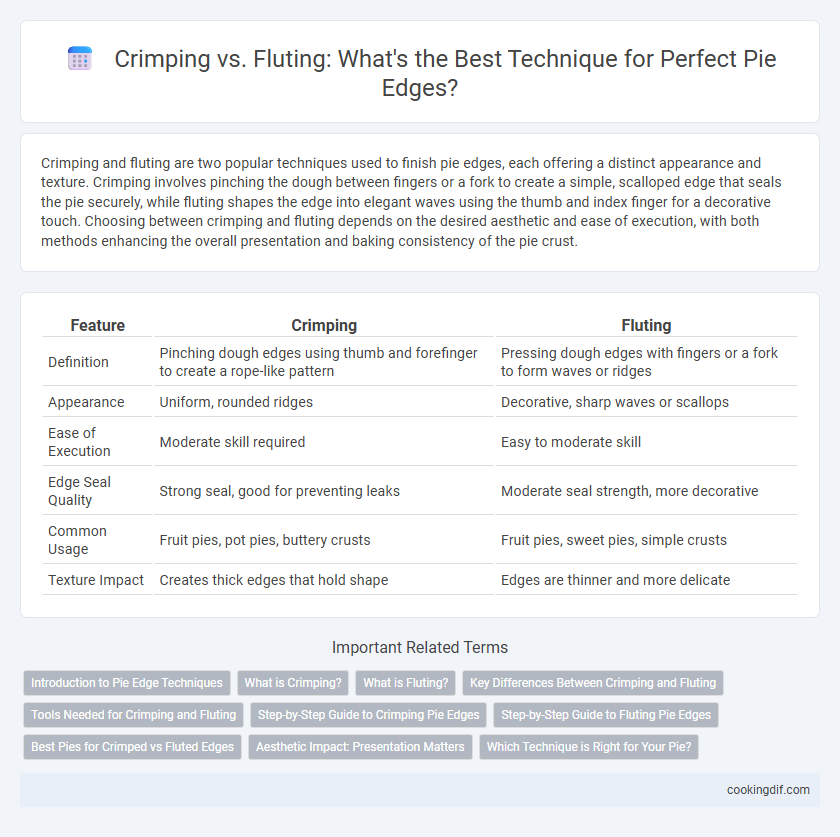Crimping and fluting are two popular techniques used to finish pie edges, each offering a distinct appearance and texture. Crimping involves pinching the dough between fingers or a fork to create a simple, scalloped edge that seals the pie securely, while fluting shapes the edge into elegant waves using the thumb and index finger for a decorative touch. Choosing between crimping and fluting depends on the desired aesthetic and ease of execution, with both methods enhancing the overall presentation and baking consistency of the pie crust.
Table of Comparison
| Feature | Crimping | Fluting |
|---|---|---|
| Definition | Pinching dough edges using thumb and forefinger to create a rope-like pattern | Pressing dough edges with fingers or a fork to form waves or ridges |
| Appearance | Uniform, rounded ridges | Decorative, sharp waves or scallops |
| Ease of Execution | Moderate skill required | Easy to moderate skill |
| Edge Seal Quality | Strong seal, good for preventing leaks | Moderate seal strength, more decorative |
| Common Usage | Fruit pies, pot pies, buttery crusts | Fruit pies, sweet pies, simple crusts |
| Texture Impact | Creates thick edges that hold shape | Edges are thinner and more delicate |
Introduction to Pie Edge Techniques
Crimping and fluting are popular pie edge techniques that create decorative, sealed crusts while enhancing the pie's visual appeal. Crimping is typically done by pinching the dough between fingers or using a fork to press the edges, which ensures a tight seal to prevent filling leakage. Fluting involves shaping the edge with a gentle wave using fingers or a specialized tool, offering an elegant finish and helping the crust bake evenly.
What is Crimping?
Crimping is a technique used to seal pie edges by pinching the dough between the thumb and forefinger to create a series of small folds or ridges. This method not only secures the filling inside but also adds a decorative touch that enhances the pie's appearance. Crimped edges tend to be sturdier, ensuring the crust holds its shape during baking and improves overall presentation.
What is Fluting?
Fluting refers to the decorative technique used to shape the edges of a pie crust by pinching the dough between fingers to create a series of uniform, wavy ridges. This method not only enhances the pie's aesthetic appeal but also helps to seal the crust, preventing filling leakage during baking. Fluting offers a delicate, elegant finish compared to the more robust and simpler crimping edge style.
Key Differences Between Crimping and Fluting
Crimping and fluting are two popular techniques used to finish pie edges, each offering distinct visual and functional differences. Crimping involves pinching the dough between fingers or a fork to create a sealed, textured edge that helps prevent filling leakage. Fluting shapes the edge using the thumb and index finger to form a decorative wave pattern, providing a more elegant appearance while also ensuring structural integrity.
Tools Needed for Crimping and Fluting
Tools needed for crimping pie edges typically include a fork or simply fingers to press and seal the dough, creating a simple, rustic design. Fluting requires more precision and often involves using the thumb and forefinger of one hand on the outside edge while the other hand pushes the dough from the inside, requiring manual dexterity rather than specialized tools. Both techniques can be enhanced with tools like pie crust shields or decorative edge presses for consistent results, but fluting largely relies on skilled hand shaping.
Step-by-Step Guide to Crimping Pie Edges
Crimping pie edges involves pinching the dough between your thumb and forefinger along the crust to create a decorative, sealed border that holds filling in place and prevents burning. Start by folding the dough edge slightly under itself, then use your fingers to press and pinch at regular intervals, forming uniform ridges all around the pie. This technique offers a classic, rustic look and ensures even baking, making it a preferred choice for fruit pies and savory quiches.
Step-by-Step Guide to Fluting Pie Edges
Fluting pie edges involves pinching the dough between your thumb and forefinger to create a decorative, wavy pattern that seals the crust and enhances presentation. Begin by placing your thumb on the inside edge of the crust and your index finger on the outside, then pinch together at intervals around the rim. This technique not only secures the filling but also adds a professional, textured finish that crimping lacks.
Best Pies for Crimped vs Fluted Edges
Crimped edges provide a rustic, sealed crust ideal for fruit pies like apple or cherry, enhancing durability and preventing juice leakage. Fluted edges, with their decorative, scalloped design, are best suited for delicate pies like custards or tarts where aesthetics and light texture are prioritized. Choosing between crimping and fluting directly influences the pie's structural integrity and visual appeal, tailored to the filling type.
Aesthetic Impact: Presentation Matters
Crimping creates a uniform, wavy pattern along pie edges that enhances visual symmetry and provides a classic, polished look. Fluting offers a more sculpted, decorative appearance, often highlighting artisanal craftsmanship and adding texture contrast to the crust. Both techniques elevate pie presentation by accentuating edge detail, making the dessert visually appealing and inviting.
Which Technique is Right for Your Pie?
Crimping creates a tight seal by pinching the dough edges together, ideal for fruit pies to prevent filling leaks during baking. Fluting shapes the crust with a decorative wavy pattern, enhancing the pie's appearance without compromising structure, making it perfect for cream or custard pies. Choosing between crimping and fluting depends on the pie type and desired presentation, balancing functionality and aesthetics.
Crimping vs fluting for pie edges Infographic

 cookingdif.com
cookingdif.com